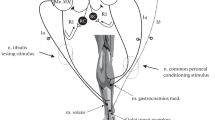Summary
Apamin, a neurotoxic polypeptide from bee venom, has been investigated for activity on the spinal cord in spinal cats. 15 minutes after intravenous injection of 0,5–1,0 mg/kg, the mean and the standard deviation of the amplitudes of the monosynaptic extensor reflex potentials increased. With monosynaptic flexor reflex potentials, no uniform influence on the mean of the amplitudes became apparent, but again the standard deviation was significantly increased by the drug. Polysynaptic reflex potentials from flexor reflex afferents were also greatly increased. While dorsal root potentials and dorsal root reflexes were slightly augmented, the effectiveness of polysynaptic inhibition exerted on the monosynaptic gastrocnemius reflex by conditioning stimulation of Ia-afferents from the posterior biceps + semitendinosus nerve became smaller. No influence of apamin on the spatial and temporal summation, on the direct inhibition, and on the recurrent inhibition could be observed using the conditioning technique. From the results it is concluded that apamin mainly augments polysynaptic reflexes and that excitatory polysynaptic pathways become more effective than inhibitory polysynaptic mechanisms.
Zusammenfassung
Die spinalen Wirkungen von Apamin, einem neurotoxischen Polypeptid aus Bienengift, wurden an spinalisierten Katzen untersucht. 15 min nach i.v. Injektion von 0,5–1,0 mg/kg war der Mittelwert und die Streuung der Amplitudenmaxima der monosynaptischen Extensorreflexpotentiale signifikant gewachsen. Die Mittelwerte der Amplitudenmaxima bei den monosynaptischen Flexorreflexpotentialen verhielten sich unter Apamin uneinheitlich, jedoch nahm die Streuung der Einzelwerte ebenfalls stark zu. Die polysynaptischen Komponenten der Reflexpotentiale nach Reizung von Flexorreflexafferenzen wurden stark vergrößert, das Dorsalwurzelpotential und der Dorsalwurzelreflex nahmen mäßig zu. Die Effektivität der polysynaptischen Hemmung eines Gastrocnemiusreflexes durch konditionierende Reizung des N. biceps post. + semitendinosus nahm jedoch ab. Mit der Konditionierungstechnik ließ sich eine Änderung der direkten Hemmung, der rekurrenten Hemmung sowie der räumlichen und zeitlichen Förderung durch Apamin nicht nachweisen. Aus den Versuchen wird geschlossen, daß Apamin vornehmlich polysynaptische Reflexbögen erregt und daß hierbei excitatorische Mechanismen stärker gefördert werden als inhibitorische.
Similar content being viewed by others
Literatur
Bradley, K. D., D. M. Easton, and J. C. Eccles: An investigation of primary or direct inhibition. J. Physiol. (Lond.) 122, 474–488 (1953).
Brooks, C. McC., K. Koizumi, and J. L. Malcolm: Effects of changes in temperature on reactions of spinal cord. J. Neurophysiol. 18, 205–216 (1955).
—— —— —— Origin of the dorsal root reflex. J. Neurophysiol. 19, 61–74 (1956).
Brooks, V. B., and V. J. Wilson: Recurrent inhibition in the cat's spinal cord. J. Physiol. (Lond.) 146, 380–391 (1959).
Carpenter, D., I. Engbert, H. Funkstein, and A. Lundberg: Decerebrate control of reflexes to primary afferents. Acta physiol. scand. 59, 424–437 (1963).
Decandia, M., and L. Provini: Motoneurone excitability during repetitive stimulation of group I afferent fibres. Experientia (Basel) 22, 187–188 (1966).
Eccles, J. C., F. Magni, and W. D. Willis: Depolarization of central terminals of group I afferent fibres from muscle. J. Physiol. (Lond.) 160, 62–93 (1962).
——, and W. D. Willis: Presynaptic inhibition on the spinal monosynaptic reflex pathway. J. Physiol. (Lond.) 161, 282–297 (1962).
—— —— —— Pharmacological studies on presynaptic inhibition. J. Physiol. (Lond.) 168, 500–530 (1963).
Frank, K., and M. G. F. Fuortes: Presynaptic and postsynaptic inhibition of monosynaptic reflexes. Fed. Proc. 16, 39–40 (1957).
Green, D. G., and J. O. Kellerth: Polysynaptic versus presynaptic inhibition in antagonistic stretch reflexes. Science 152, 1097–1099 (1966).
Haase, J., u. Ü. Tan: Die excitatorischen Wirkungen von Desoxyephedrin (Pervitin) auf die tonische Spinalmotorik der Katze. Naunyn-Schmiedebergs Arch. exp. Path. Pharmak. 252, 20–31 (1965).
Habermann, E.: Recent studies in Hymenoptera venoms. Proc. II. Int. Pharmacol. Meet. Prague 1963, Vol. 9, pp. 53–62. Oxford: Pergamon 1965.
——, u. K.-G. Reiz: Ein neues Verfahren zur Gewinnung der Komponenten von Bienengift, insbesondere des zentral wirksamen Peptids Apamin. Biochem. Z. 341, 451–466 (1965).
Haux, P., H. Sawerthal u. E. Habermann: Sequenzanalyse des Bienengift-Neurotoxins (Apamin) aus seinen tryptischen und chymotryptischen Spaltstücken. Hoppe-Seylers Z. physiol. Chem. 348, 737–738 (1967).
Jefferson, A. A., and W. Schlapp: Some effects of repetitive stimulation of afferents on reflex conduction. In: Wolstentolme, G. E. W. (Edit.): Ciba Found. Symp. on The Spinal Cord. Boston: Little and Brown 1953.
Jong, R. H. de, R. Robles, and K. I. Morikawa: Gallamine (Flaxedil) and synaptic transmission in the spinal cord. Science 160, 768–769 (1968).
Lloyd, D. P. C.: Neuron patterns controlling transmission of ipsilateral handlimb reflexes in cat. J. Neurophysiol. 6, 293–315 (1943).
—— Facilitation and inhibition of spinal motoneurones. J. Neurophysiol. 9, 421–438 (1946).
——, and V. J. Wilson: Reflex depression in rhythmically active monosynaptic reflex pathways. J. gen. Physiol. 40, 409–426 (1957).
Rudomin, P., and H. Dutton: Effects of presynaptic and postsynaptic inhibition on the variability of the monosynaptic reflex. Nature (Lond.) 216, 292–293 (1967).
Swerdlow, Y. S., and V. I. Alekseeva: Effect of tetanus toxin on presynaptic inhibition in the spinal cord. Fed. Proc. 25, T 931-T 936 (1966).
Weber, Erna: Grundriß der biologischen Statistik, 6. Aufl. Jena: G. Fischer 1967.
Author information
Authors and Affiliations
Additional information
Herrn Prof. Dr. L. Lendle zum 70. Geburtstag gewidmet.
Rights and permissions
About this article
Cite this article
Wellhöner, HH. Spinale Wirkungen von Apamin. Naunyn-Schmiedebergs Arch. Pharmak. u. Exp. Path. 262, 29–41 (1969). https://doi.org/10.1007/BF00536816
Received:
Issue Date:
DOI: https://doi.org/10.1007/BF00536816




